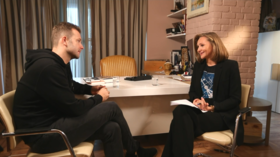‘What are we celebrating, exactly?’ Documentary examines Ukraine’s tumultuous journey, 30 years after Kiev separated from the USSR
In 1991, Ukraine departed the USSR with a strong industrial base, and a broadly well educated population of 52 million. Many believed the country had a bright future. Now, three decades on, a documentary examines the results.
In the intervening period, Kiev has seen mass emigration and two Western-backed street ‘revolutions’, the second of which ended with the violent removal of a democratically elected government. That 2014 event unleashed a calamitous civil war, which has turned the country into the de-facto frontline of a geopolitical struggle between Russia and the expansionary US-led NATO military bloc.
Ukraine has also lost Crimea – which was gifted to the then-Soviet Republic by Nikita Khrushchev, who grew up in the Donbass, in the 1950s – after the peninsula refused to accept the outcome of the ‘Maidan’ and voted to rejoin Russia.
Today, official Ukrainian figures claim the country has a population of 37 million, but informed sources suggested in 2018 the real number was closer to 30 million. Either way, the situation is a top contender for one of the largest peacetime drops in recorded history.
Also on rt.com Ukraine turns 30: On landmark anniversary of independence, Europe’s second-largest country remains divided about its future pathIt was all so different in 1991. Back then, as Kiev was about to leave the Soviet Union, nationalists from the People’s Movement were distributing leaflets arguing that, given its economic resources and human capital, the young country, free and self-sufficient, would be as prosperous as France.
However, Ukraine’s path turned out to be filled with challenges, Ukrainian-born filmmaker Igor Lopatonok says in his new documentary. ‘The Everlasting Present – Ukraine: 30 Years of InDependence’.
The film points out that Ukraine had the second-largest industrial sector among Soviet republics, behind only Russia, and, by some estimates, its economic potential was indeed comparable to developed European nations like Germany and France.
But most of Ukraine’s production was closely tied to Moscow and other parts of the USSR. Severing those ties, often purely for idealogical reasons, threw the country into various crises, the documentary says.
Also on rt.com Ukraine condemned for crackdown on media freedom by OSCE after leading news organisation 'Strana' banned by Zelensky government“The elite that existed in 1991 was absolutely not ready for independence because there was no understanding of the concept of statehood,” Ukrainian lawmaker Andrey Derkach said in the documentary.
The flow of Western investment into heavy industry was far below expectations, the film explains. At the same time, the privatization of state factories and plants, guided by a team of American consultants, was, according to Ukraine’s former economy minister, Viktor Suslov, “criminal” in nature, because it gave power to a class of oligarchs. A similar situation prevailed in Russia, during the 1990s, but in Kiev it continues to this day.
Nevertheless, partly due to the global rise of the price of steel, Ukraine’s main export, by the 2000s, the economy began to recover.
In 2005, Viktor Yushchenko rose to the presidency following Western-supported protests known as the Orange Revolution.
The new president employed divisive nationalistic rhetoric, and brought Ukraine closer to NATO. He lost the election to arch-rival Viktor Yanukovich, who was later ousted in 2014 following the 'Maidan' insurrection. The film describes how, once again, this movement was backed by the US.
The violent seizure of power by pro-Western and nationalistic elements in Kiev was widely rejected in Crimea – which voted in a referendum to join Russia – and some eastern parts of the country which revolted against the new regime. The rest of Ukraine, meanwhile, fell under Washington’s control, the documentary claims.
The movie details how civil war and the ensuing chaos further crippled the economy, incentivizing many to escape poverty and rampant corruption and look for a better life elsewhere.
“The result of the country’s development in 30 years is the loss of industry, loss of population, loss of territory, confrontational relations with all countries with which Ukraine has a border, and defending other countries’ interests without taking into account the interests of its own people,” Derkach said. “So what are we celebrating exactly?”
Think your friends would be interested? Share this story!













